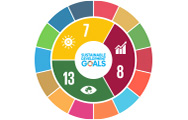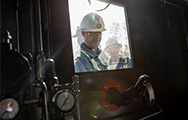Chart generator
|
2019 |
2018 |
2017 |
2016 |
2015 |
2014 |
2013 |
2012 |
2011 |
2010 |
||||||||||||||||||||||||||||||||
|---|---|---|---|---|---|---|---|---|---|---|---|---|---|---|---|---|---|---|---|---|---|---|---|---|---|---|---|---|---|---|---|---|---|---|---|---|---|---|---|---|---|---|
Greenhouse gas emissions (GHGs) |
|
|
|
|
|
|
|
|
|
|
||||||||||||||||||||||||||||||||
Total GHG Emissions |
|
|
|
|
|
|
|
|
|
|
||||||||||||||||||||||||||||||||
Net Carbon Footprint (gCO2e/MJ) |
78 |
79 |
79 |
79 |
|
|
|
|
|
|
||||||||||||||||||||||||||||||||
Direct GHG emissions (Scope 1) (million tonnes CO2 equivalent) [A] |
70 |
71 |
73 |
70 |
72 |
76 |
73 |
72 |
74 |
76 |
||||||||||||||||||||||||||||||||
Carbon dioxide (CO2) (million tonnes) |
67 |
68 |
70 |
67 |
68 |
73 |
71 |
69 |
71 |
72 |
||||||||||||||||||||||||||||||||
Methane (CH4) (thousand tonnes) [O] |
91 |
92 |
123 |
138 |
132 |
134 |
120 |
102 |
143 |
128 |
||||||||||||||||||||||||||||||||
Nitrous oxide (N2O) (thousand tonnes) |
1 |
1 |
1 |
1 |
1 |
1 |
1 |
1 |
1 |
2 |
||||||||||||||||||||||||||||||||
Hydrofluorocarbons (HFCs) (tonnes) [O] |
29 |
31 |
22 |
21 |
20 |
16 |
18 |
23 |
22 |
23 |
||||||||||||||||||||||||||||||||
Energy indirect GHG emissions (Scope 2) (million tonnes CO2 equivalent) [B] |
10 |
11 |
12 |
11 |
9 |
10 |
10 |
9 |
10 |
9 |
||||||||||||||||||||||||||||||||
GHG emissions associated with exported energy (subset of direct GHGs) |
3 |
3 |
3 |
3 |
2 |
3 |
|
|
|
|
||||||||||||||||||||||||||||||||
Use of our refinery and natural gas products (Scope 3 Category 11) (million tonnes CO2 equivalent) [P] |
576 |
599 |
579 |
600 |
560 |
600 |
600 |
580 |
570 |
670 |
||||||||||||||||||||||||||||||||
GHG emissions breakdown by business (Scope 1 and 2) |
|
|
|
|
|
|
|
|
|
|
||||||||||||||||||||||||||||||||
Scope 1 – Upstream (million tonnes CO2 equivalent) |
12.9 |
14.8 |
19.6 |
18.7 |
|
|
|
|
|
|
||||||||||||||||||||||||||||||||
Scope 1 - Integrated Gas (million tonnes CO2 equivalent) |
16.3 |
13.0 |
12.0 |
13.7 |
|
|
|
|
|
|
||||||||||||||||||||||||||||||||
Scope 1 – Downstream (million tonnes CO2 equivalent) |
40.3 |
42.2 |
41.1 |
37.6 |
|
|
|
|
|
|
||||||||||||||||||||||||||||||||
Scope 2 - Upstream [B] (million tonnes CO2 equivalent) |
1.1 |
1.4 |
1.4 |
1.4 |
|
|
|
|
|
|
||||||||||||||||||||||||||||||||
Scope 2 - Integrated Gas [B] (million tonnes CO2 equivalent) |
1.6 |
2.4 |
2.4 |
2.0 |
|
|
|
|
|
|
||||||||||||||||||||||||||||||||
Scope 2 - Downstream [B] (million tonnes CO2 equivalent) |
7.3 |
6.8 |
7.5 |
7.3 |
|
|
|
|
|
|
||||||||||||||||||||||||||||||||
GHG intensity by Business |
|
|
|
|
|
|
|
|
|
|
||||||||||||||||||||||||||||||||
Upstream and Integrated Gas GHG intensity |
0.168 |
0.158 |
0.166 |
0.166 |
|
|
|
|
|
|
||||||||||||||||||||||||||||||||
Refinery GHG intensity |
1.06 |
1.05 |
1.14 |
1.18 |
|
|
|
|
|
|
||||||||||||||||||||||||||||||||
Chemical GHG intensity |
1.04 |
0.96 |
0.95 |
0.99 |
|
|
|
|
|
|
||||||||||||||||||||||||||||||||
Flaring |
|
|
|
|
|
|
|
|
|
|
||||||||||||||||||||||||||||||||
Flaring (upstream) (million tonnes CO2 equivalent) [C] [O] |
5.9 |
5.2 |
8.2 |
7.6 |
11.8 |
12.5 |
8.0 |
7.7 |
10.7 |
10.6 |
||||||||||||||||||||||||||||||||
Flaring (upstream) (million tonnes hydrocarbon flared) [C] [O] |
1.8 |
1.5 |
2.5 |
2.3 |
3.5 |
3.7 |
2.4 |
2.3 |
3.4 |
3.5 |
||||||||||||||||||||||||||||||||
Nigeria [D] [O] |
0.7 |
0.6 |
0.8 |
0.5 |
0.9 |
1.2 |
1.2 |
1.5 |
2.0 |
2.4 |
||||||||||||||||||||||||||||||||
Rest of the world [E] |
1.2 |
1.0 |
1.7 |
1.8 |
2.6 |
2.5 |
1.1 |
0.8 |
1.4 |
1.0 |
||||||||||||||||||||||||||||||||
Energy intensity |
|
|
|
|
|
|
|
|
|
|
||||||||||||||||||||||||||||||||
Upstream excl. oil sands, LNG and GTL (gigajoules per tonne production) [C] [F] |
1.07 |
1.06 |
1.05 |
1.02 |
0.83 |
0.87 |
0.89 |
0.83 |
0.75 |
0.74 |
||||||||||||||||||||||||||||||||
Refineries: Refinery Energy Index [G] |
94.4 |
94.3 |
94.8 |
95.4 |
95.4 |
94.9 |
95.6 |
98.4 |
100.8 |
101.8 |
||||||||||||||||||||||||||||||||
Chemical plants: Chemicals Energy Intensity |
19.7 |
18.3 |
17.6 |
18.9 |
19.6 |
|
|
|
|
|
||||||||||||||||||||||||||||||||
Acid gases and VOCs |
|
|
|
|
|
|
|
|
|
|
||||||||||||||||||||||||||||||||
Sulphur oxides (SOx) (thousand tonnes SO2) [O] |
65 |
74 |
81 |
83 |
88 |
97 |
99 |
113 |
136 |
139 |
||||||||||||||||||||||||||||||||
Nitrogen oxides (NOx) (thousand tonnes NO2) |
108 |
111 |
107 |
113 |
104 |
146 |
144 |
147 |
146 |
159 |
||||||||||||||||||||||||||||||||
Volatile organic compounds (VOCs) (thousand tonnes) [O] |
55 |
59 |
95 |
153 |
131 |
151 |
89 |
89 |
129 |
147 |
||||||||||||||||||||||||||||||||
Ozone-depleting emissions |
|
|
|
|
|
|
|
|
|
|
||||||||||||||||||||||||||||||||
CFCs/ |
0.0 |
0.0 |
0.0 |
0.0 |
0.0 |
0.0 |
0.0 |
0.0 |
0.0 |
0.0 |
||||||||||||||||||||||||||||||||
Hydrochlorofluorocarbons (HCFCs) (tonnes) |
8 |
9 |
7 |
8 |
8 |
6 |
8 |
8 |
12 |
21 |
||||||||||||||||||||||||||||||||
Spills and discharges [H] [O] |
|
|
|
|
|
|
|
|
|
|
||||||||||||||||||||||||||||||||
Sabotage spills – volume (thousand tonnes) [I] |
2.0 |
1.6 |
1.4 |
3.9 |
2.3 |
2.7 |
2.2 |
3.3 |
1.6 |
3.0 |
||||||||||||||||||||||||||||||||
Sabotage spills – number [I] |
157 |
111 |
62 |
49 |
95 |
139 |
157 |
138 |
118 |
112 |
||||||||||||||||||||||||||||||||
Operational spills – volume (thousand tonnes) |
0.2 |
0.9 |
0.4 |
0.8 |
0.8 |
0.7 |
0.9 |
1.9 |
6.0 |
2.9 |
||||||||||||||||||||||||||||||||
Nigeria [J] |
0.03 |
0.4 |
0.1 |
0.3 |
0.2 |
0.3 |
0.4 |
0.2 |
5.3 |
0.7 |
||||||||||||||||||||||||||||||||
Rest of the world |
0.2 |
0.5 |
0.3 |
0.5 |
0.7 |
0.4 |
0.5 |
1.8 |
0.7 |
2.2 |
||||||||||||||||||||||||||||||||
Operational spills – number |
70 |
93 |
104 |
72 |
108 |
158 |
174 |
207 |
211 |
195 |
||||||||||||||||||||||||||||||||
Nigeria [K] |
7 |
15 |
10 |
8 |
16 |
40 |
31 |
37 |
64 |
32 |
||||||||||||||||||||||||||||||||
Rest of the world |
63 |
78 |
94 |
64 |
92 |
118 |
143 |
170 |
147 |
163 |
||||||||||||||||||||||||||||||||
Hurricane spills – volume (thousand tonnes) [L] |
0.0 |
0.0 |
0.3 |
0.0 |
0.0 |
0.0 |
0.0 |
0.0 |
0.0 |
0.0 |
||||||||||||||||||||||||||||||||
Oil in effluents to surface environment (thousand tonnes) |
1.3 |
1.4 |
1.2 |
1.0 |
1.0 |
0.9 |
1.1 |
1.0 |
1.3 |
1.6 |
||||||||||||||||||||||||||||||||
Water [M] |
|
|
|
|
|
|
|
|
|
|
||||||||||||||||||||||||||||||||
Fresh water withdrawn (million cubic metres) [O] |
192 |
199 |
201 |
195 |
186 |
199 |
198 |
203 |
219 |
212 |
||||||||||||||||||||||||||||||||
Fresh water consumed (million cubic metres) |
145 |
147 |
150 |
152 |
141 |
165 |
|
|
|
|
||||||||||||||||||||||||||||||||
Waste disposal |
|
|
|
|
|
|
|
|
|
|
||||||||||||||||||||||||||||||||
Hazardous (thousand tonnes) [O] |
698 |
592 |
638 |
658 |
474 |
529 |
698 |
820 |
740 |
1,048 |
||||||||||||||||||||||||||||||||
Non-hazardous (thousand tonnes) [O] |
1,414 |
1,407 |
1,382 |
1,491 |
1,820 |
1,674 |
2,056 |
2,295 |
1,850 |
1,079 |
||||||||||||||||||||||||||||||||
Total waste (thousand tonnes) [N] [O] |
2,113 |
1,999 |
2,020 |
2,148 |
2,294 |
2,203 |
2,755 |
3,115 |
2,590 |
2,127 |
||||||||||||||||||||||||||||||||
|
||||||||||||||||||||||||||||||||||||||||||
|
|
2019 |
2018 |
2017 |
2016 |
2015 |
2014 |
2013 |
2012 |
2011 |
2010 |
||||||||||||||||||
|---|---|---|---|---|---|---|---|---|---|---|---|---|---|---|---|---|---|---|---|---|---|---|---|---|---|---|---|---|---|
|
Gender diversity [A] |
|
|
|
|
|
|
|
|
|
|
||||||||||||||||||
|
In supervisory/professional positions (% women) |
30.8 |
29.9 |
29.1 |
28.0 |
28.0 |
29.0 |
28.8 |
28.1 |
27.3 |
26.3 |
||||||||||||||||||
|
In management positions (% women) |
24.5 |
23.7 |
22.3 |
21.0 |
20.0 |
21.0 |
18.8 |
18.2 |
17.6 |
17.0 |
||||||||||||||||||
|
In senior leadership positions (% women) |
26.4 |
24.0 |
22.2 |
20.0 |
19.0 |
18.2 |
17.2 |
16.2 |
16.6 |
15.3 |
||||||||||||||||||
|
Staff forums and grievance procedures |
|
|
|
|
|
|
|
|
|
|
||||||||||||||||||
|
% countries with staff access to staff forum, grievance procedure or other support system |
100 |
100 |
100 |
100 |
100 |
100 |
100 |
100 |
99 |
100 |
||||||||||||||||||
|
Child labour (% countries with procedures in place) |
|
|
|
|
|
|
|
|
|
|
||||||||||||||||||
|
Own operations |
100 |
100 |
100 |
100 |
100 |
100 |
100 |
100 |
100 |
99 |
||||||||||||||||||
|
Contractors and suppliers |
100 |
100 |
100 |
100 |
100 |
100 |
100 |
100 |
97 |
96 |
||||||||||||||||||
|
Forced labour (% countries with procedures in place) |
|
|
|
|
|
|
|
|
|
|
||||||||||||||||||
|
Own operations |
100 |
100 |
100 |
100 |
100 |
100 |
100 |
100 |
100 |
99 |
||||||||||||||||||
|
Contractors and suppliers |
100 |
100 |
100 |
100 |
100 |
100 |
100 |
100 |
97 |
95 |
||||||||||||||||||
|
Integrity |
|
|
|
|
|
|
|
|
|
|
||||||||||||||||||
|
Code of Conduct violations [B] |
263 |
370 |
261 |
341 |
217 |
267 |
181 |
209 |
226 |
205 |
||||||||||||||||||
|
Contracting and procurement |
|
|
|
|
|
|
|
|
|
|
||||||||||||||||||
|
Estimated expenditure on goods and services in lower-income countries ($ billion) [C] [D] |
5.7 |
4.1 |
4.9 |
4.4 |
6 |
14 |
12 |
14 |
12 |
13 |
||||||||||||||||||
|
Social investment [E] |
|
|
|
|
|
|
|
|
|
|
||||||||||||||||||
|
Estimated voluntary social investment (equity share) ($ million) |
173 |
113 |
111 |
103 |
122 |
160 |
159 |
149 |
125 |
121 |
||||||||||||||||||
|
Estimated social investment spend (equity share) in lower-income countries ($ million) [F] |
84 |
102 |
107 |
96 |
43 |
73 |
74 |
67 |
45 |
61 |
||||||||||||||||||
|
|||||||||||||||||||||||||||||
|
|
2019 |
2018 |
2017 |
2016 |
2015 |
2014 |
2013 |
2012 |
2011 |
2010 |
||||||||
|---|---|---|---|---|---|---|---|---|---|---|---|---|---|---|---|---|---|---|---|
|
Fatalities |
|
|
|
|
|
|
|
|
|
|
||||||||
|
Total number |
7 |
2 |
2 |
3 |
7 |
5 |
5 |
8 |
6 |
12 |
||||||||
|
Employees |
3 |
0 |
0 |
0 |
1 |
3 |
0 |
3 |
1 |
0 |
||||||||
|
Contractors |
4 |
2 |
2 |
3 |
6 |
2 |
5 |
5 |
5 |
12 |
||||||||
|
Fatal accident rate (FAR) |
1.3 |
0.4 |
0.4 |
0.5 |
1.1 |
0.7 |
0.8 |
1.3 |
1.0 |
1.6 |
||||||||
|
Fatalities per 100 million working hours (employees and contractors) |
|
|
|
|
|
|
|
|
|
|
||||||||
|
Injuries and process safety incidents |
|
|
|
|
|
|
|
|
|
|
||||||||
|
Total recordable case frequency (TRCF) |
0.9 |
0.9 |
0.8 |
1.0 |
0.9 |
1.0 |
1.2 |
1.3 |
1.2 |
1.2 |
||||||||
|
Injuries per million working hours (employees and contractors) |
|
|
|
|
|
|
|
|
|
|
||||||||
|
Lost time injury frequency (LTIF) |
0.3 |
0.3 |
0.2 |
0.3 |
0.3 |
0.3 |
0.4 |
0.3 |
0.4 |
0.3 |
||||||||
|
Lost time injuries per million working hours (employees and contractors) |
|
|
|
|
|
|
|
|
|
|
||||||||
|
Operational process safety events |
|
|
|
|
|
|
|
|
|
|
||||||||
|
Tier 1 [B] |
41 |
35 |
49 |
41 |
51 |
57 |
65 |
91 |
n/c |
n/c |
||||||||
|
Tier 2 [B] |
89 |
86 |
117 |
110 |
169 |
194 |
246 |
308 |
n/c |
n/c |
||||||||
|
Illnesses |
|
|
|
|
|
|
|
|
|
|
||||||||
|
Total recordable occupational illness frequency (TROIF) |
0.5 |
0.4 |
0.3 |
0.4 |
0.6 |
1.0 |
0.8 |
0.5 |
0.7 |
0.8 |
||||||||
|
Illnesses per million working hours (employees only) |
|
|
|
|
|
|
|
|
|
|
||||||||
|
Security |
|
|
|
|
|
|
|
|
|
|
||||||||
|
Using armed security (% of countries) |
20 |
21 |
14 |
17 |
19 |
24 |
19 |
17 |
14 |
9 |
||||||||
|
Using armed company security (% of countries) |
1 |
3 |
1 |
1 |
1 |
1 |
3 |
0 |
1 |
1 |
||||||||
|
Using armed contractor security (% of countries) |
11 |
10 |
3 |
7 |
8 |
10 |
8 |
10 |
9 |
6 |
||||||||
|
|||||||||||||||||||
 Climate change
Climate change
 Sustainable development goals
Sustainable development goals
 Safety
Safety
 About our data
About our data